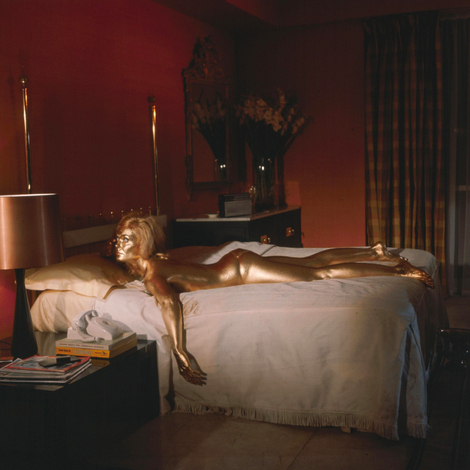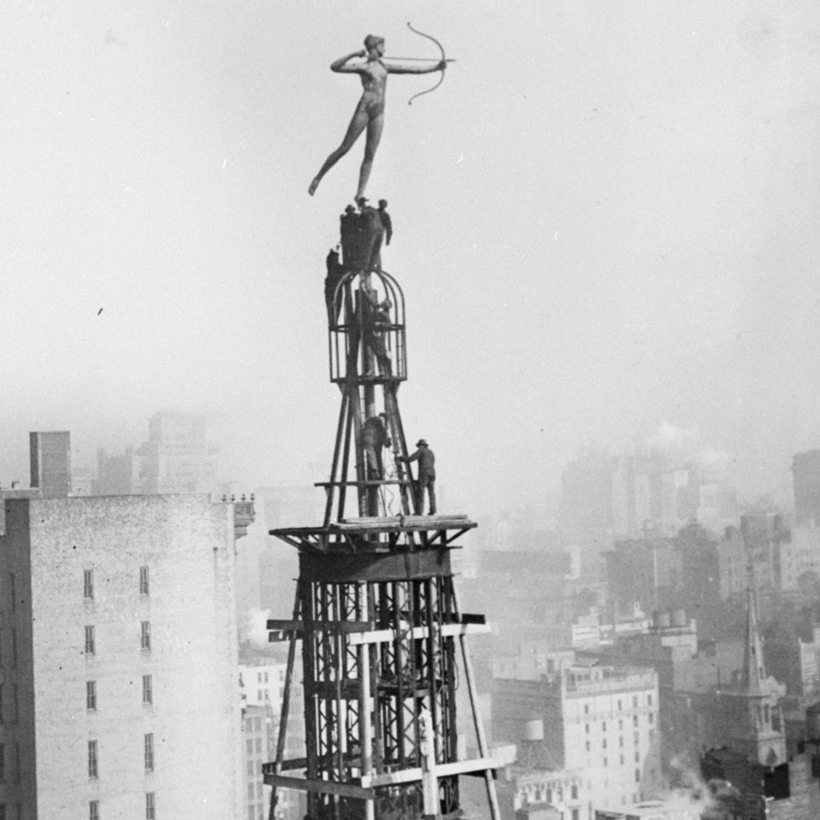“I should like to be a genius,” the artist and diplomat Maitland Armstrong wrote in 1899, pondering the shrouded statue that the sculptor Augustus Saint-Gaudens had placed at the grave of Marian “Clover” Hooper Adams, in Rock Creek Cemetery, in Washington, D.C., at a site designed by the architect Stanford White. It was part of a chorus of admiration and consternation brought on by the ambiguous, androgynous figure—a statue marked by an “absence of Christian joy or hope,” yet charged with some other, ineffable feeling, Henry Wiencek writes in Stan and Gus: Art, Ardor, and the Friendship That Built the Gilded Age.
In 1890, while work on the tomb was still underway, the man who had commissioned it, Clover Adams’s widower, Henry Adams, had a different outlook on the artistic spirit of its creators. “If I could,” he wrote, “I should club St Gaudens and Stanford White and put them under their own structure.” Before Adams could end up visiting the finished memorial “almost daily” and writing to Saint-Gaudens to marvel at the statue’s mystery, he first had to endure nearly five years of false starts, evasions, and excuses from the duo.

The partnership and friendship between the two men—White, the descendant of a formerly prosperous society family, and Saint-Gaudens, the French-Irish immigrant son of a shoemaker to the fashionable set—left its legacy all over the 20th-century American landscape: the Robert Gould Shaw memorial along Boston Common, the monument to Admiral David Farragut in Madison Square Park, Saint-Gaudens’s William Tecumseh Sherman statue and White’s Washington Square Arch punctuating the two ends of lower Fifth Avenue.
But it went beyond artistic collaboration, Wiencek writes, to “an affective bond and, at least at times, an erotic relationship,” while also being a business relationship, in which both men’s aesthetic inspirations and erratic temperaments, and particularly Saint-Gaudens’s recalcitrant creativity, were supposed to serve the aspirations of their illustrious, or at least prodigiously wealthy, clients. What emerged from that junction of money and genius was logistical slapstick, and no small amount of human damage, in the pursuit of the sublime.

Wiencek tells how the two first met, with White barging up from the street into Saint-Gaudens’s studio, drawn by the sound of the sculptor singing to himself; how they served separate supporting roles, with White as junior draftsman and Saint-Gaudens painting frescoes, in the “creative chaos” of Boston’s repeatedly revamped Trinity Church; how they teamed up to win the commission to make—and eventually to deliver—a larger-than-life bronze of Farragut by Saint-Gaudens on an innovative curved pedestal by White. “Suddenly, other commissions began pouring in,” Wiencek writes. “Thus began Gus’s lifelong habit of juggling major projects simultaneously and never finishing any of them on time.”
The United States was awash in money, and the sculptor and architect gave that money something to do. The prosperous businessman and former New York governor Edwin Morgan wanted to build a family tomb, and White deliberately showed him a plan that “that would cost more than twice what Morgan had budgeted,” successfully playing on his pride. The project, and the battle over payment for it, sprawled on for years—including an episode where a fire destroyed a group of marble angels Saint-Gaudens had belatedly made for the tomb but had not insured; by the time the mausoleum was completed, Morgan was already dead and inside it.

Who put the shine on the Gilded Age? Mark Twain’s original sarcastic metaphor of a name, distinguishing the superficial American version from the golden ages of myth, has itself been beaten to tissue through the years. But Wiencek relays Saint-Gaudens’s own childhood reminiscences of watching craftsmen at work, “‘four or five men with big, strong, bare arms with big veins on them,’ hammering gold until it was so thin ‘you could blow it away.’” Amid the evanescent ostentation and the mercenary spirit of the times, artists and artisans were striving for beauty, even hoping to reach eternity.
White was a prolific commercial builder, as the partner getting the smallest share of profits in the storied firm of McKim, Mead & White. He was guided, Wiencek writes, by his insight that New York “is actually located at the same latitude as Madrid. Stan responded to the light; he built in Mediterranean colors of yellow and gold, blond terra-cotta, and gleaming marble.”
Saint-Gaudens, meanwhile, owed some part of his endless procrastination and revision to his excessive concern for posterity: “Books, plays, paintings, and even buildings could crumble to dust, but for better or worse, sculptures, even bad ones, tended to last forever.” His son, Wiencek notes, set down “a fragmentary remark that later in life his father worried over the trousers of the Farragut.”

As the book’s first-name approach conveys, Wiencek is caught up in the charisma of his subjects and in their enthusiasms, for art and for one another: “‘Holy Moses! Gin and seltzer!’ [Stan] wrote to Gus after visiting a museum in Lille where ‘I gasped for breath’ at a wax head by Raphael and ‘gorged’ on Rubens.” Later on, less elevatedly, he quotes Gus writing to Stan: “I’m your man to dine, drink, Fuck bugger or suck.”
Who exactly the last part applied to was vague and open-ended. “Their shifting sexual and emotional relationships defy labels,” Wiencek writes in the book’s prologue, considerably understating the case. Their various same- and opposite-sex entanglements mostly involved other people or activities in the Sewer Club, a small group organized by White for, Wiencek writes, “sexual adventuring with both men and women.” But in the summer of 1879, on a trip together to Italy, something apparently happened between them directly; in a letter White wrote to Saint-Gaudens, he waved off some earlier unrecorded offer of apology from the sculptor for “things you did in Italy & wherever” and told him, “I would do anything for you.”
Charmed though he is by the two, Wiencek gives their bad habits their due. Saint-Gaudens may have been the more bohemian of the two toward professional deadlines, but he was more respectable or at least discreet with his vices, maintaining a secret second family and home with his model and mistress Davida Clark in Noroton Heights, Connecticut, while White kept chorus girls cycling through a mirrored bedroom in Manhattan, not all of them willingly.
Both men were neglectful and outright cruel husbands to their lawful spouses. White let his wife, Bessie, know that he hadn’t bothered to open her letters while traveling, because he was sure the contents would be too boring, while Saint-Gaudens’s wife, Gussie, had to watch the sculptor take down a portrait he’d made of their son from the wall in their country home and replace it with one of his son with Clark.
White was shot dead at the age of 52 as he watched a show in the theater in the tower of Madison Square Garden—a building of his own design, crowned with a nude golden statue of the goddess Diana, sculpted by Saint-Gaudens and based on Clark. The killer was the violently jealous husband of Evelyn Nesbit, a stage beauty whom White had raped when she was a teenager new to the city.

Saint-Gaudens would die of cancer the next year, at age 59. Their spectacular Madison Square Garden would be demolished in 1925, in favor of a new Madison Square Garden, which would be demolished in 1968 in favor of the current Garden, which people have been drawing up plans to get rid of for years.
The gleam of a Gilded Age is evanescent by nature. Among White’s volatile and ill-fated business concerns, Wiencek notes, was a side business as a decorator and shopper for his ultra-rich architectural clients, in which he would loot Europe of masterpieces of décor commissioned by the bygone fortunes of the Renaissance and install them on this side of the Atlantic, taking a 10-percent commission along the way.
Out on Long Island, White built the second-largest mansion in the country, an extravaganza in “blue Indiana limestone, the costliest material of the era,” for the heir to the Comstock Lode fortune; it was “dynamited in 1947 to make way for a suburban housing development.”
The Madison Square Garden Diana—once visible, in a wash of electric light, “from as far away as Greenwich, Connecticut, if one had a proper telescope”—now stands, bright with restored gold leaf, in the Philadelphia Museum of Art.
Tom Scocca is the editor of Indignity and a member of Flaming Hydra


